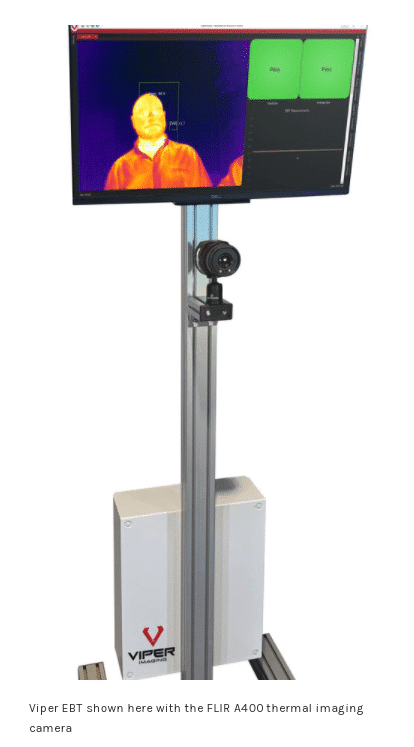Viper Elevated Body Temperature Measurement FAQ
You’ve probably heard something by now about elevated body temperature (EBT) measurement using thermal imaging. Many are saying that this will become a part of our “new normal” as businesses begin to reopen and we all slowly come out of quarantine. Do you have questions about this application of thermal technology? The Viper team has fielded numerous inquiries at this point, and we’ve compiled many of them here. An EBT FAQ, if you will.
What is Infrared and how does it work? Invisible to the human eye, infrared is radiant energy that we can sense as heat. Thermal imaging cameras measure the radiated infrared energy of an object and convert that mathematically to a temperature based on the radiance of an object being measured. Each pixel on the camera has a calibrated temperature reading.
Does the Viper EBT system detect the Coronavirus? No. As a means of helping to prevent the spread of Coronavirus (COVID-19), these thermal imaging systems serve as a pre-screening device. It identifies elevated body temperature (EBT) which could be indicative of a fever (one of the symptoms of a viral infection). While these are not medical devices and do not replace conventional medical testing, they can be used to give an early indication when used properly. According to the CDC, 85% of those admitted to the hospital with confirmed cases of Coronavirus had fever* symptoms.
*CDC – Characteristics of Patients Hospitalized with Laboratory-Confirmed Coronavirus
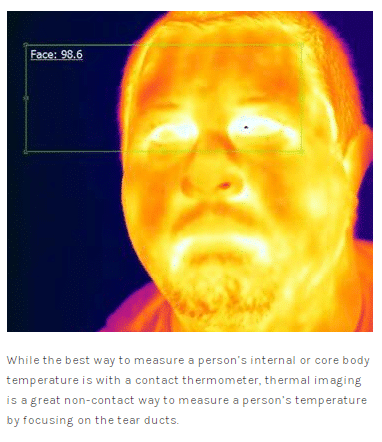
How do we screen for elevated body temperature? Thermal imaging is an excellent non-contact screening tool to detect people with elevated body temperature – if used correctly. When screening for body temperature on the face, the most reliable focal point for temperature measurement is the eye canthus (or tear duct). This is the only area on the face that provides reliable results correlating to the body’s core temperature if the subject is in normal ambient conditions.
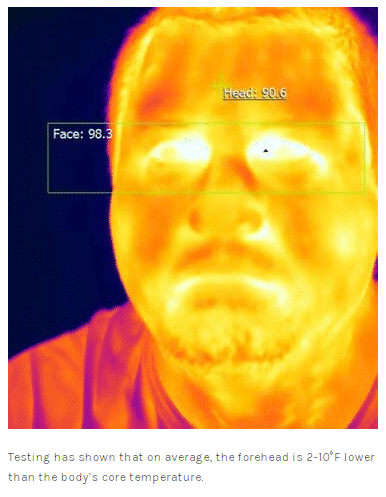
Many people are making the claim that they can measure large groups of people. Can we do this with infrared? NO! Best practices dictate that you should measure the tear duct. No other region on the face can offer reliable measurement. Note the image example, where we are measuring in the tear duct region and getting a reading of 98.3°F (36.8°C). At the same time, a reading on the forehead is measuring 90.6°F (32.6°F) – a full 7.7° F lower. Forehead readings also are not consistent from person to person.** Testing has shown that the forehead is anywhere on average from 2°F to 10°F lower than the body’s core temperature. This makes it impossible to look at mass groups of people to randomly take readings of the face and get accurate results. When looking at large groups, you cannot have a spot size small enough to capture the tear duct. It is also important to note thermal imaging cannot “see through” glasses. Standard glass is opaque to infrared.
Does the Viper EBT system have FDA 510(K) clearance? The Viper system is intended for adjunctive use with FDA cleared thermal imaging cameras [510(K) K033967]. The Viper EBT detection system is a non-contacting imaging system designed to sense elevated body temperatures by measuring passive infrared emissions from the tear ducts or open mouths of humans. The Viper EBT system modifies use of FDA cleared thermal cameras [510(k) K033967] by configuring additional components and proprietary ViperVision EBT Max software to automate body temperature screening that can be remotely monitored. This product is not intended to diagnose or monitor any medical condition or illness and should not be used as such.
What is the process to make this reading correctly?
-
The system is used best when put in an environmentally controlled area.
-
The subject needs to stand still in front of the camera, typically 2’ to 10’ away depending on the FOV, or lens being used.
-
The region of the tear duct is approximately 5mm large, so the spot size of the camera needs to be smaller than that, depending on how many pixels are used for measurement.
-
Glasses (and any obstruction on the face) must be removed.
-
A region of interest (ROI) needs to be drawn around the eyes to obtain a maximum temperature in that area. That is done for you in our ViperVision software.
-
Subject needs to look toward the camera so the eyes are visible.
-
Alarm parameters are set up to trigger on body temperature above a certain threshold.
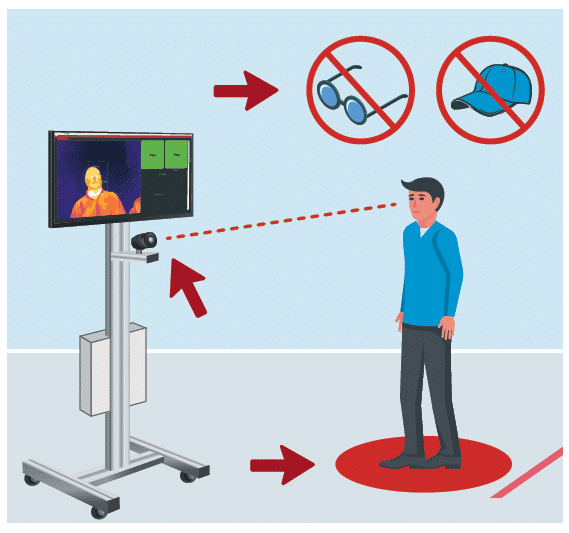
How does Viper have the knowledge to supply EBT Systems to address the COVID-19 Pandemic? Thermal imaging technology has been used for EBT for over 15 years – since the SARS, Avian Bird Flu and the Swine Flu epidemics. The Viper team has decades of experience applying thermal imaging technology – for EBT measurement, as well as a host of other applications for various industries.
What is the accuracy of a thermal imaging camera on its own? The standard specification for most thermal imaging cameras, is +/- 2°C or (+/- 3.6°F) or +/- 2% when calibrated and looking at a black body calibration furnace. This does not mean when you take a camera out of the box, power it up and point it at an object, that you are within that camera specification.
Several factors go into making thermal temperature reading reliable and accurate, such as:
-
Emissivity the measure of an object’s ability to emit infrared energy. Emitted energy indicates the temperature of the object. Emissivity can have a value from 0 (shiny mirror) to 1.0 (blackbody).
-
Spatial Resolution (Spot Size) based on the number detector pixels and the field of view (FOV) of the lens being used. This combination defines the area the imager sees at any given moment. Spatial resolution can be used to help define the smallest object size that can be detected
-
Detector/Camera Noise
-
Camera Drift
Do environmental conditions affect the temperature measurement reading from the camera? Yes. This is apparent when someone comes inside from cold weather conditions. The body and tear duct region is exposed to the cold and will read colder until the body normalizes and regulates temperature. This could take up to several minutes.
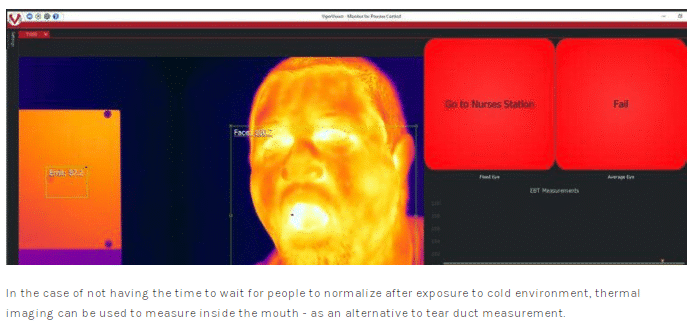
What if I do not have time to wait for people to normalize prior to scanning? There are two common methods that people will use.
a. Rolling Average: As you collect readings, a rolling average will be established. You can then alarm on an amount above average.
b. Measure inside the mouth: A person’s core temperature can be measured by looking inside the mouth. Since this is a different measurement than the Tear Duct method, the settings including emissivity will be different. With ViperVision Max software, you can use different recipes. For instance, if we get the external or outdoor weather conditions, we can automatically switch over to this method.
How is the Viper System more accurate than other systems on the market, or by just using thermal imaging cameras on your own? First, we understand the application and how to make the measurement correctly.
-
We know that by following [FDA-recommended] best practices, the only area externally on the face is the tear duct.
-
We understand the requirement for cameras that have a small spot size, and utilize the correct optics and distance measurement.
-
Infrared cameras can drift when their internal temperature changes. This can happen as they warm up from start up – or if ambient conditions change. If this isn’t compensated for, temperature readings will be incorrect.
-
We utilize Calibrated Reference Emitters in the scene’s field of view (FOV). That temperature is fed back into the software and compared to what the camera is actually reading. If there is any error on the camera, the system constantly corrects for that within the software. For instance, when we use a reference emitter, we feed that temperature back in to an I/O device. If the reading from the thermocouple is 90.0°F, and the Thermal Camera is reading 91.2°F, we know the camera is reading 1.2°F high, and the system can adjust the parameters to compensate for this and constantly re-calibrate the camera to read correctly based on a known source.
-
By using these methods, the Viper EBT system can achieve better than 0.5°F accuracy.
Can you personalize the Pass/Fail Messages? Yes. If someone’s reading was above a certain threshold, you might want to give them instructions to “Go to Nurses Station” or “Get tested at your Doctor’s Office.” Messages can easily be customized to match the protocol at your facility.
Is the Viper EBT System Automated? The EBT Ultra and Viper V1 Systems are set up to be automated. Once a person is standing in front of the camera, we can set a predetermined time to get their reading, typically 1 to 3 seconds. If they are below a certain threshold, then they will get a Pass (or Green indicator). If their temperature is elevated above a certain threshold, then they will get a Fail (Red indicator).
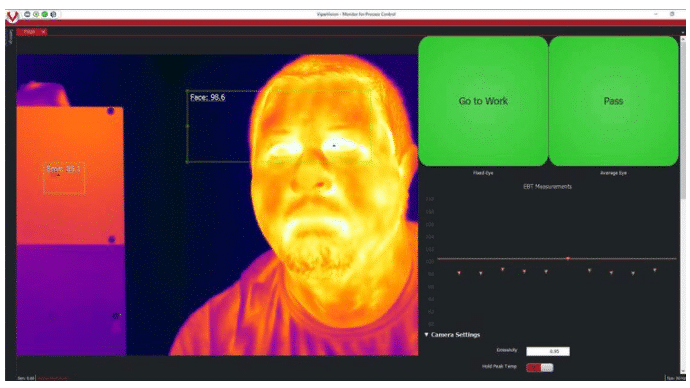
Is there a way to save these images and access them on our system? Images can be saved, either on an input or alarm. If connected to the customer network, we can use our built in email feature to provide images or reports over email or text alerts.
Can the system be tied in to Access Control? Yes. Since we use different modes of Communications Protocols (Digital IO, OPC, Modbus, Ethernet IP), we can communicate with external devices (both input and output).
We hope this answers a lot of your questions. Our team has combined decades of experience using thermal imaging technology to solve some very unique and complex issues. During this challenging time, we understand many businesses are doing their best to survive while maintaining some sense of normalcy. They are trying to be as productive as possible while at the same time, preventing personnel who may be sick or contagious from entering areas that can affect others.
We are passionate about our technology, and we believe in helping our customers stay productive while promoting a safe environment for their employees – and patrons as some businesses are beginning to reopen. As a result, most of our company resources right now are dedicated to EBT solutions.
Could this be a solution for you? Contact us today.
